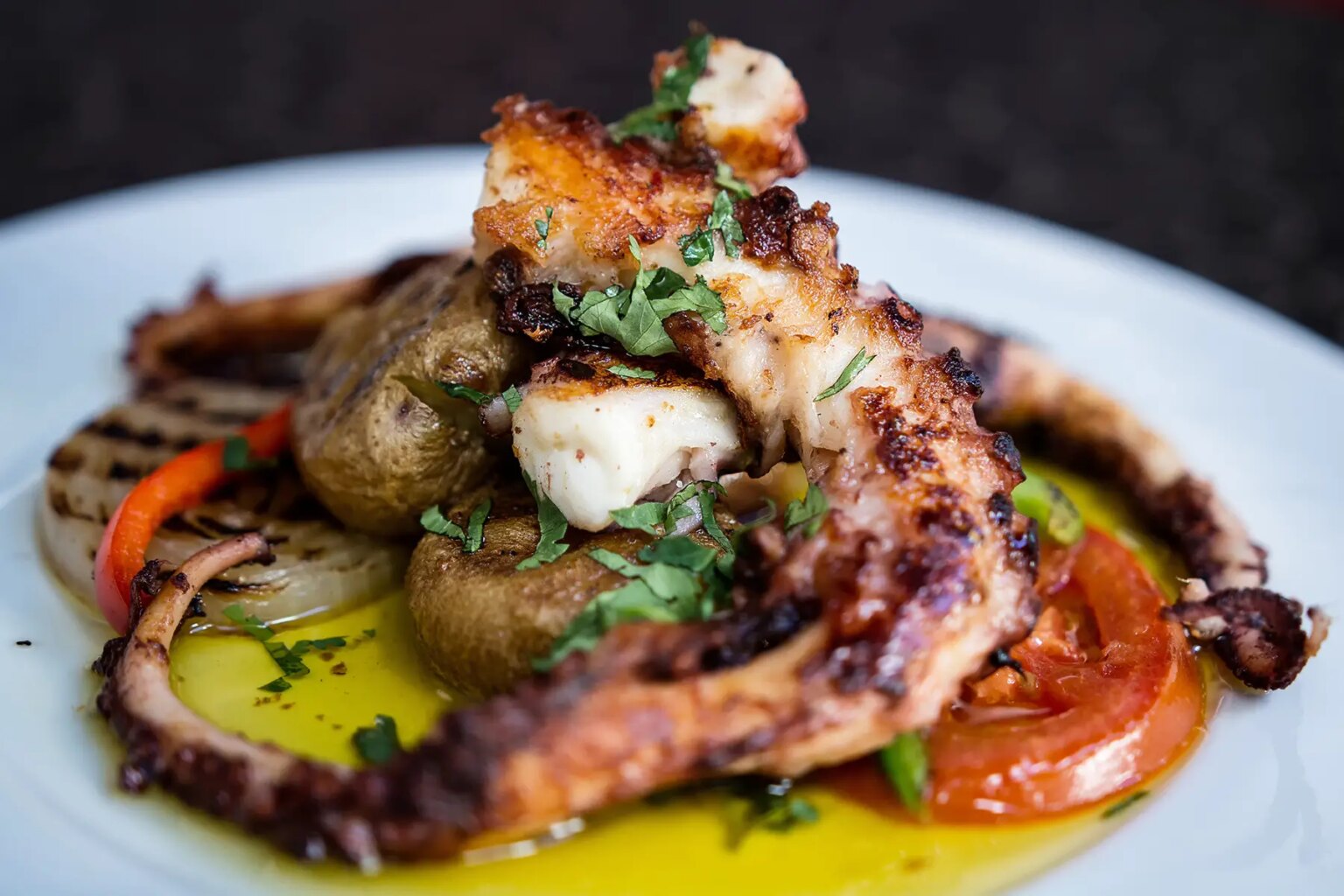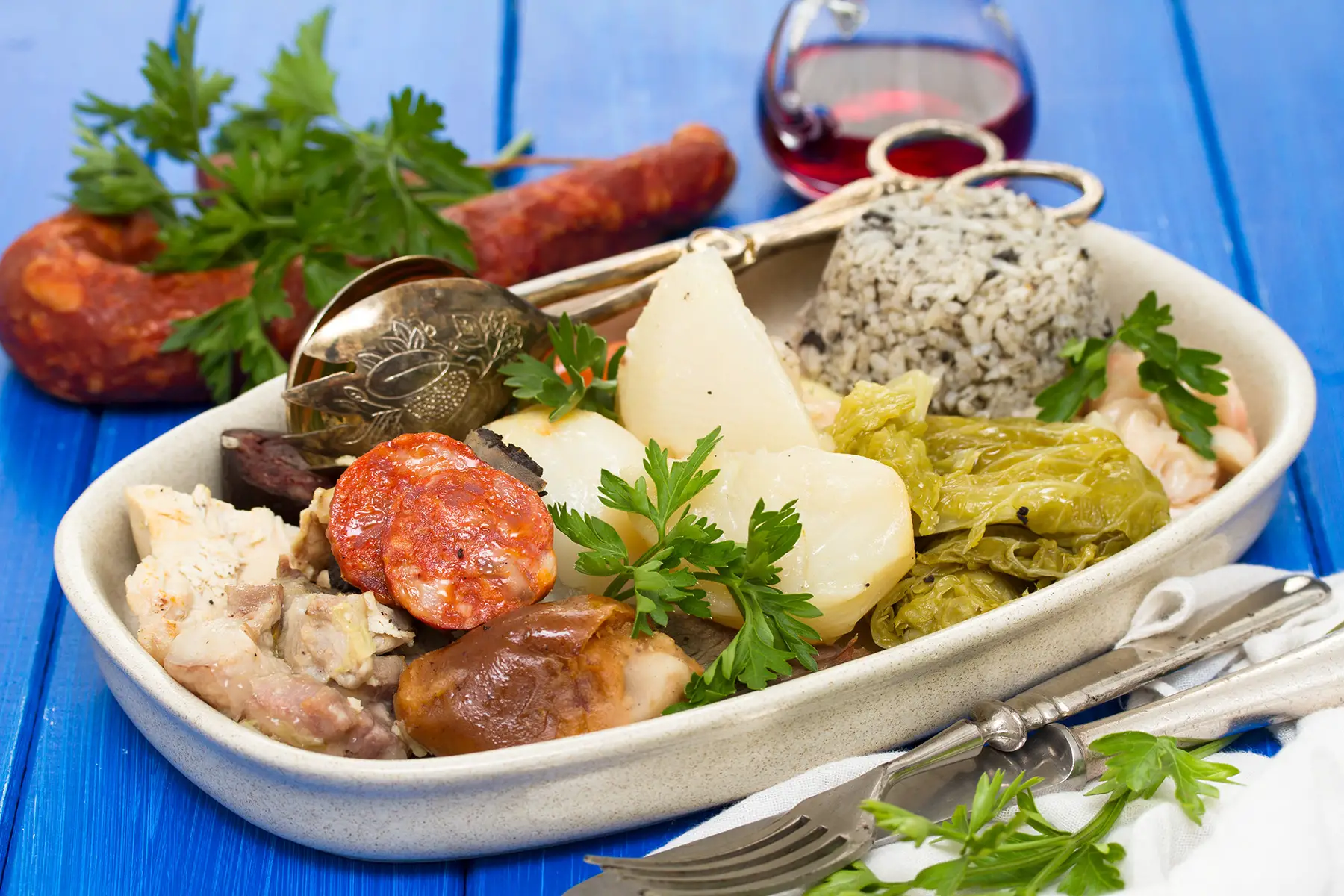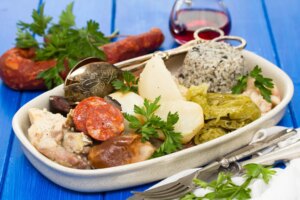If you like seafood and a Mediterranean diet, then you’ll likely enjoy Portugal’s vibrant food culture. But beyond fish, you can look forward to discovering a wealth of delights that vary from region to region. This features everything from rich cheeses and unique bread to smoky sausages and sweet pastries; all rounded off with delicious Port, of course.
To give you an idea of what culinary treats are in store, this guide to Portuguese cuisine includes the following information:
An overview of Portuguese cuisine
Portugal’s role in world exploration and colonization began as far back as 1279 when King Diniz invested in expanding the country’s navy. By the late 1300s, Portuguese sea captains were among the best in Europe and had successfully completed many expeditions. They were the first European country to dock in China, Japan, and Ethiopia, bringing back with them many new, exotic products. As a result, the Portuguese played a major role in food globalization. They brought rice and tea from Asia, coffee and peanuts from Africa, and pineapples, peppers, tomatoes, and potatoes from the New World. The Portuguese also brought coriander, pepper, ginger, curry, saffron, and paprika to Europe.

Due to the country’s long and extensive history of colonization, you can find Portuguese influences in cuisines throughout the world. For instance, Brazilian cuisine features its own versions of Portuguese dishes, while regional specialties in Macau and Goa also incorporate Portuguese flavors. Furthermore, the nation is credited with introducing corn on the African continent. Tea also became fashionable in England in the 1660s after the Portuguese princess Catherine of Braganza (Catarina De Bragança) brought her preference of leaves from the colony of Macau to the English court.
In recent years, Portugal has struggled with economic inequality and, consequently, health and nutritional challenges. In fact, the World Health Organization (WHO) found that a diet high in trans fatty acids, sugar, and salt has led to an increased rate of obesity, diabetes, and malnutrition in the country. As a result, the Portuguese government is now working to promote more nutritious food and beverage choices. Despite this, however, the recent Global Nutrition Report found that Portugal still needs improvement in order to become a healthier country.
The Portuguese diet
Portuguese cuisine is primarily based on hearty peasant food and a Mediterranean diet. Seafood lovers will no doubt enjoy the impact of the country’s long Atlantic coastline on traditional dishes. Flavors and ingredients also vary across the different regions of Portugal.
Breakfast
In Portugal, breakfast is called pequeno almoço, which means ‘little lunch’. People tend to eat this before 9:00 in the morning. As its name suggests, it is indeed a small affair, often consisting of fresh bread with butter, ham, and cheese or jam. People also eat breakfast cereal mixed with milk or yogurt and fruit. Morning beverages usually consist of coffee, milk, and tea.

Sweet pastries are also very popular for breakfast in Portugal, particularly freshly-baked pastel de nata which are one of the country’s classics. People love to enjoy these with a shot of espresso in the morning or even as an afternoon treat.
Lunch
Lunch (almoço) gets much more attention in Portugal and often lasts more than an hour, between 12:00 and 14:00. Even when eaten in the workplace, lunch is a social occasion. Both lunch and dinner in Portugal typically have three main courses, including soup. A common Portuguese soup is caldo verde (‘green broth’) which consists of pureed potato, onion, and garlic.
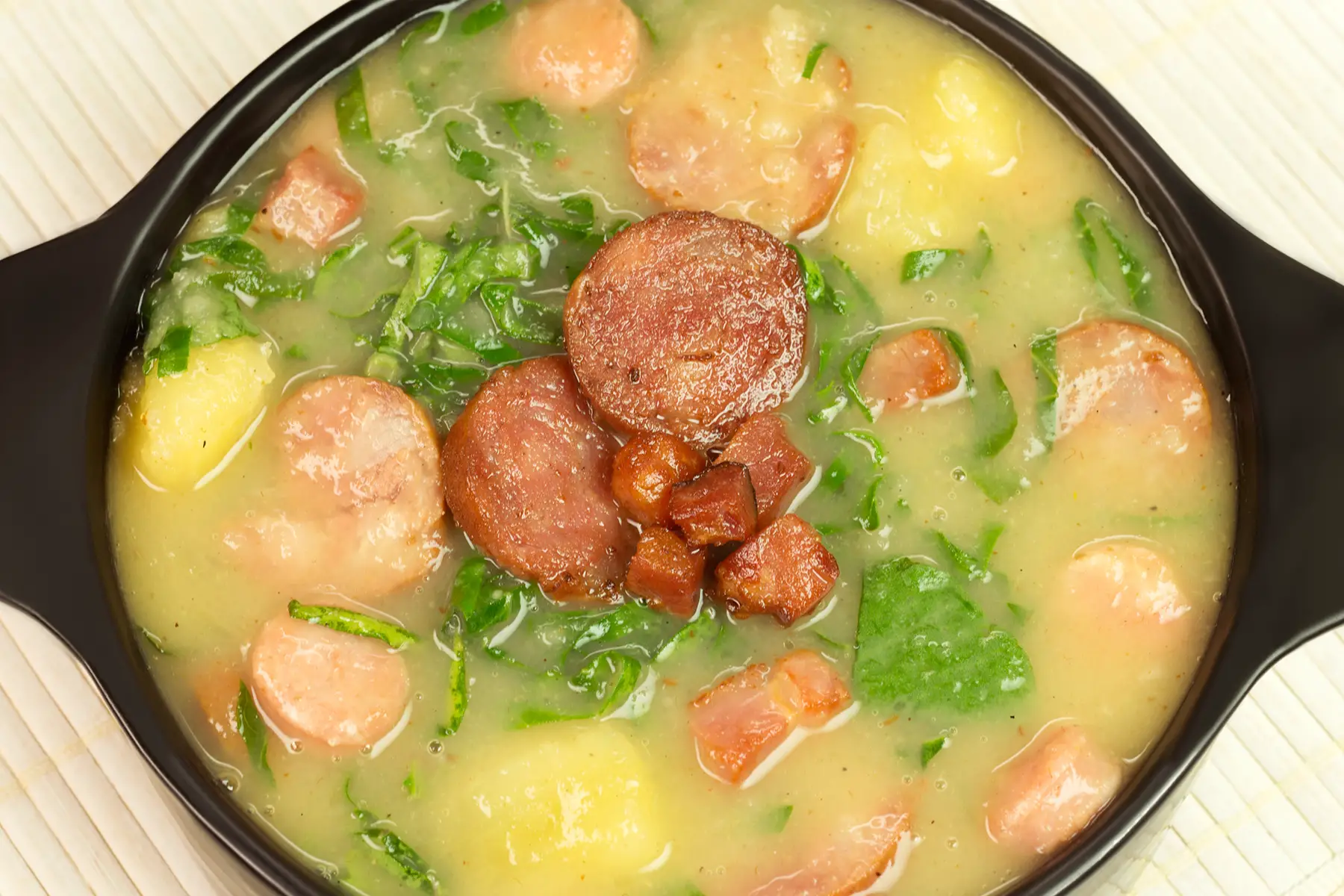
Shredded collard greens are then added. The recipe can be vegetarian, however, you’ll often find it with slices of chouriço (a smoked or spicy Portuguese sausage).
Dinner
You’ll be thankful for your long, substantial lunch as you wait for dinner time to arrive in Portugal. Dinner (jantar) is usually eaten between 20:00 and 21:00, and sometimes even later on weekends. As mentioned, it consists of at least three courses and includes soup. Sometimes soups are even served as the main course. One such soup is sopa de marisco, which is shellfish soup with wine.

Other Portuguese cuisine specialties include caldeirada, a stew made with several types of fish, and carne de porco a Alentejana, pork covered with clam and tomato sauce. Although main dishes in Portugal usually feature meat or fish, peixinhos da horta is a mainstay vegetarian recipe.
Snacks
Anyone who is happy to graze all day will enjoy lanche in Portugal. While the word looks similar to lunch, it actually means ‘snack’. It isn’t uncommon to snack between breakfast and lunch in Portugal. For instance, you might not have already had your pastel de nata for the day.
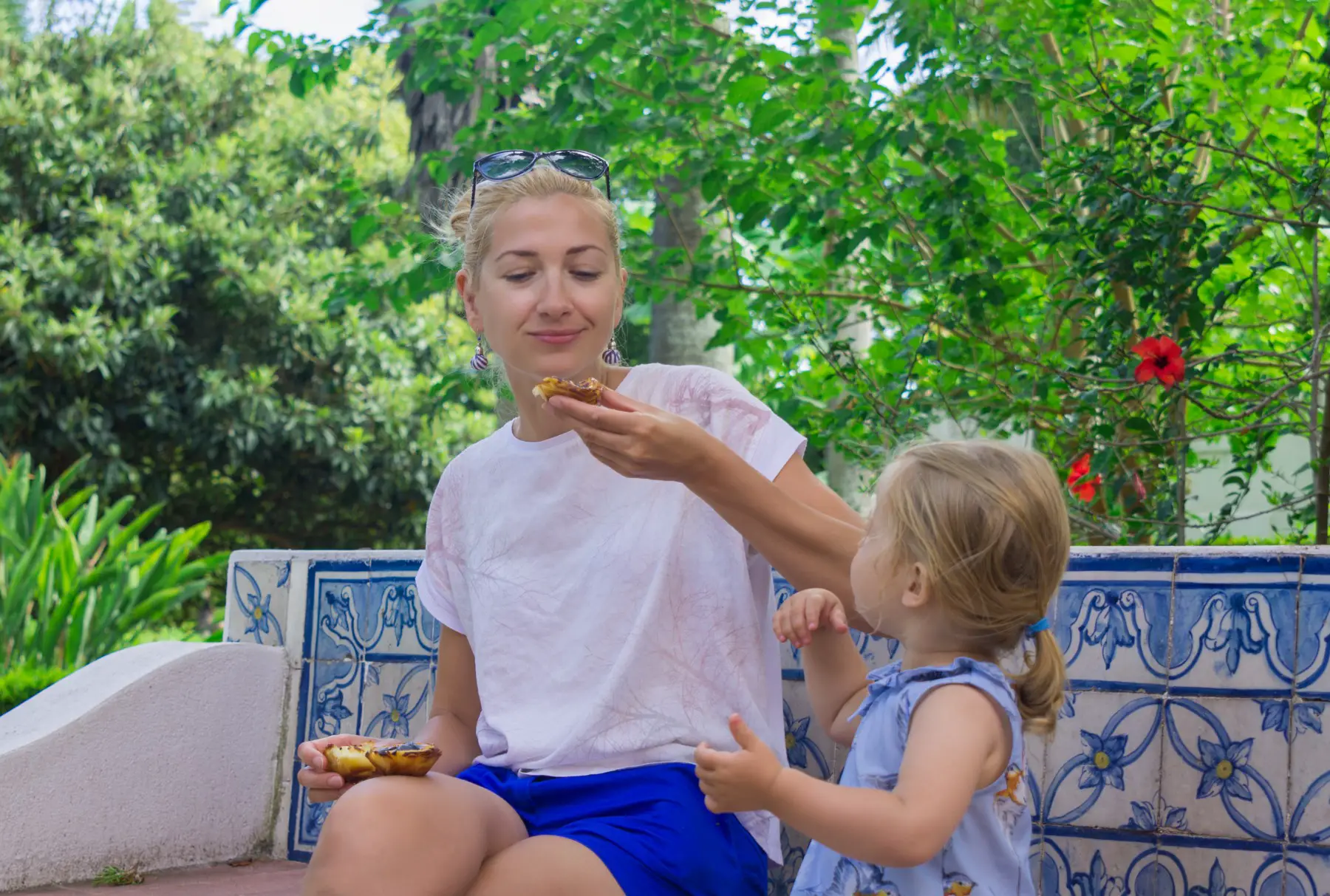
As well as enjoying a morning snack, the Portuguese will often head to the café for another sweet or savory bite at around 16:00. Popular snacks to eat during this time include pastéis de bacalhau (codfish cakes), rissóis de camarão (shrimp turnovers), torrada (thick, buttery toast), and tosta mista (grilled ham and cheese).
Special meals in Portuguese cuisine
Like all countries, Portugal has a range of special meals that people enjoy at particular times of the year to mark certain occasions. Below are some of the most traditional ones that you may come across.
Christmas Eve dinner
The Portuguese call Christmas Eve dinner Consoada. This is one of the most important dinners of the year and the national dish of bacalhau (dried, salted cod) is a favorite for the occasion. The tradition of eating bacalhau on Christmas Eve originated from a time when Portugal was a primarily Catholic country and religious followers were not supposed to eat meat the day before Christmas. Since vegetarianism wasn’t really a concept for most of Portugal’s history, they considered eating fish to be the same as abstaining from meat completely. And before the days of refrigeration and quick transportation, cured cod meant easier access to fish for everyone.

Portuguese rice pudding, arroz doce, is a typical dessert that you will find on the Christmas table. During this time, people also enjoy eating sonhos and filhós; both of which are similar to doughnuts, as well as turnovers with a sweet or savory filling called azevias. And don’t be too shocked if you’re served a plate with a treat in the shape of a snake, either. This is just the Lampreia de Natal which is made from egg yolk, sugar, and almonds. Finally, if you don’t think that you have room for all of these treats in just one sitting, then you might want to sample some of them at a Portuguese Christmas market instead.
New Year’s Eve meal
If you didn’t get to enjoy enough fish throughout the year, then you will certainly make up for it on New Year’s Eve in Portugal. In this case, it is often bacalhau cozido; boiled cod with simple potatoes and cabbage cooked in water. Notably, the Portuguese tend to keep this dish simple in anticipation of the many desserts they will enjoy after midnight mass.
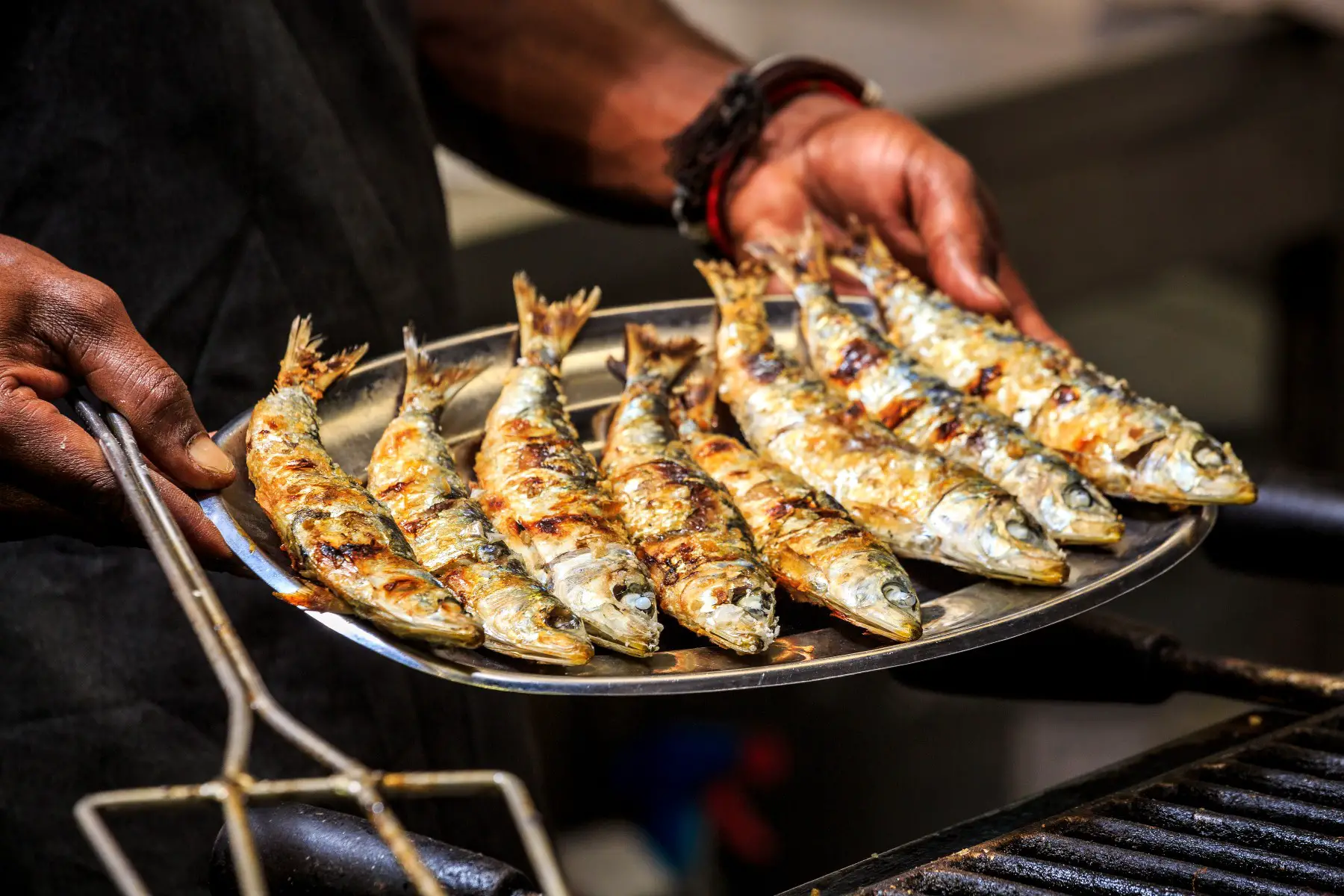
Portuguese families often dedicate an entire table to sweet treats on New Year’s Eve. According to tradition, this smorgasbord of delights is kept full for several days to welcome any visitors. Among them is often the bolo rei (king’s cake). This contains dried fruits and is garnished with crystallized fruits, and made to resemble a crown.
Easter meal
Easter is an important religious holiday in Portugal and a time for most people to enjoy a big, delicious lunch with their families. They’ll often eat cabrito, a roasted lamb served with roasted potatoes and chestnuts. Folar is a type of traditional Easter bread that is made from a special flour and filled with various sausages. Some of them also have eggs on top. For sweets, you’ll certainly encounter a lot of chocolate almonds around the holiday. Easter in Portugal is also synonymous with Pão-de-Ló, a cake that can be dry or moist, depending on the region you are in.
Festival foods
The Portuguese celebrate their culture and religious traditions with big festivals. While they hold these throughout the year, most fall between May and July. Of course, special foods are essential to these festivities. For instance, during the Feast of Saint Anthony festival (dia de Santo António) on 12 June, the Alfama district of Lisbon is the place to go for grilled sardines. The tradition celebrates the story of how a fish emerged from the sea to listen to the 13th-century saint when the locals wouldn’t.
Popular ingredients in Portuguese cuisine
Portuguese cuisine incorporates a wide variety of meat, seafood, vegetables, and fruits. Regionality also plays a big role when it comes to the types of food and cooking methods used throughout the country. Below is an overview of the most common ingredients that you are likely to come across in both Portuguese homes and restaurants.
Meats in Portugal
Portuguese cuisine features a lot of different meats (carne) with a strong preference for pork. Some different meats that you will often find on menus include the following:
- Borrego – lamb
- Cabrito – goat
- Carne de porco – pork
- Entrecosto – rib
- Febras – pork steaks
- Fiambre – ham
- Espetadas – kebabs marinated in wine and garlic
- Pato – duck
- Perdiz – partridge
- Peru – turkey
- Presunto – prosciutto ham
- Porco preto – Portuguese domestic pig
- Vaca – beef
- Vitela – veal

A popular Portuguese meat dish is Bife à Portuguesa which is a grilled steak prepared in a Port sauce. Meanwhile, leitão assado da bairrada (roasted pig) is a beloved pork dish. Portuguese cold cuts and sausages (charcutaria and enchidos) are also commonly enjoyed throughout the country and the nation has long and varied traditions when it comes to how they are prepared, seasoned, preserved, and even consumed. Other popular sausages include farinheira, a smoked variety, and alheira, which is from Trás-os-Montes and traditionally served with fried potatoes and a fried egg.
Fish in Portugal
The Portuguese are proud of their fish with bacalhau (codfish) being the star of the country’s cuisine. Two classic cod recipes are Bacalhau a gomes de sa (cod with potato, egg, and olives) and pasteis de bacalhau (little cod cakes). Sardines (sardinhas) are also popular and served at every Portuguese barbecue and celebration. Iinguado (sole), salmonete (red mullet), mexilhões (mussels), polvo (octopus), and peixe espada (swordfish) are also commonly found across the country.
Vegetables in Portugal
Interestingly, before the Portuguese brought potatoes back from the Americas, chestnuts were a staple food in their cuisine. Nowadays, potatoes and other starchy vegetables, leafy greens, and beans are common within Portuguese cuisine.
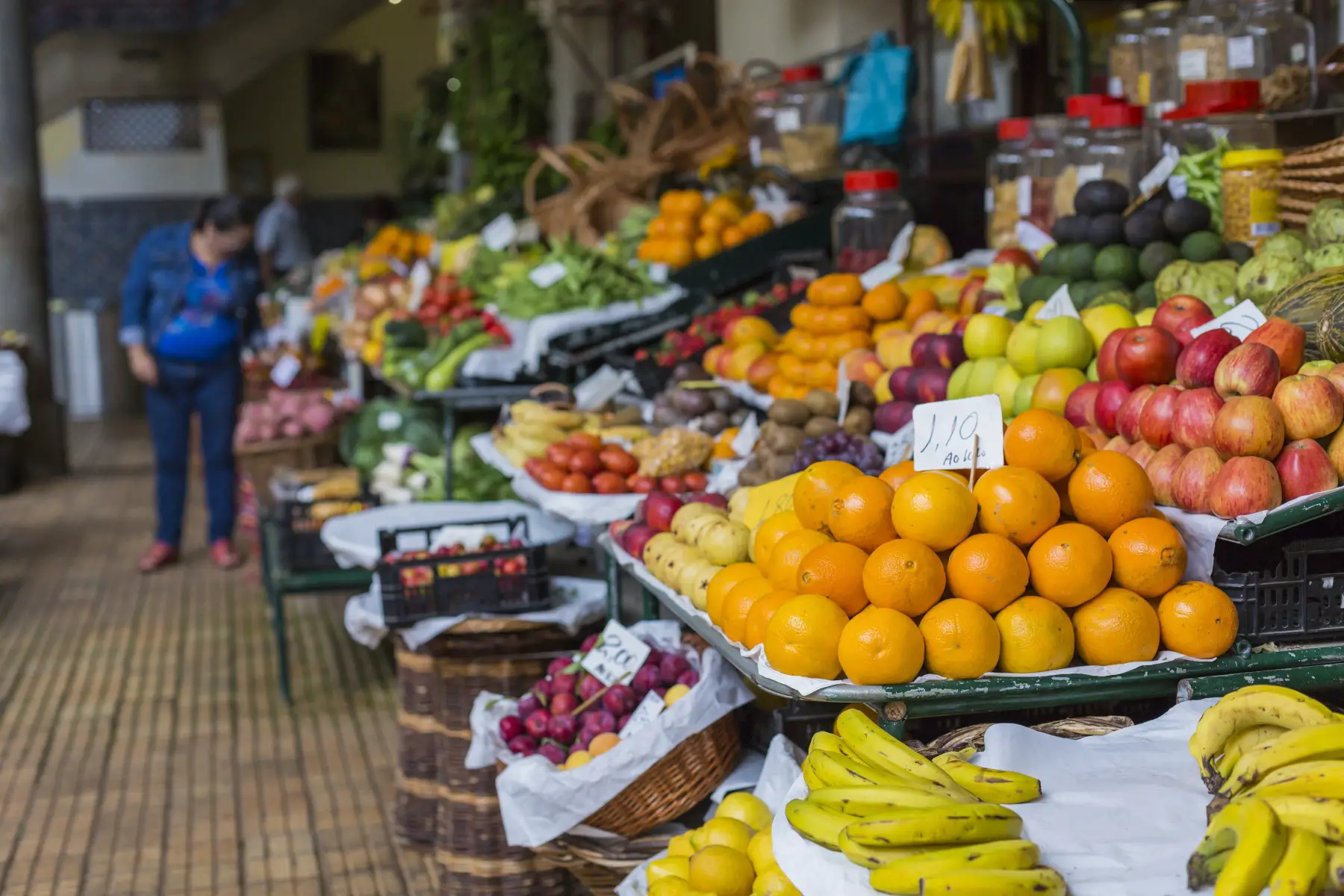
Some vegetables that you will likely see in recipes include the following:
- Azeitonas – olives
- Batatas – potatoes
- Batatas fritas – fried potatoes
- Cherovia – a type of parsnip that grows in Portugal
- Couve – cabbage
- Ervilhas – peas
- Feijoa – beans
Portuguese cuisine features several different vegetable-based soups. These include caldo verde (cabbage and potato soup), sopa de feijão verde (green bean soup), sopa de grao (chickpea soup), and sopa de legumes (vegetable soup).
Fruit in Portugal
Locally grown seasonal fruits also crop up on a regular basis in Portugal. Of course, as well as eating them fresh, people also include them in jams, liqueurs, and other desserts. These fruits include the following:
- Ameixas – plums
- Cerejas – cherries
- Maçã – apple
- Pera – pear
- Uvas – grapes
Carbohydrates in Portugal
Portugal has several unique types of bread (pão) that vary by region. Here are some to look out for at your local bakery (padaria):
- Pão Alentejano or pão de cabeça – made from wheat flour and baked in a wood oven; used in dishes that are typical to the Alentejo region, such as migas (bread-based dumplings) and açorda (a bread-based soup)
- Broa de milho or pão de milho – cornbread from Northern Portugal
- Bolo de caco – soft bread from the island of Madeira
- Bolo de caco – made from flour and sweet potato and cooked on a hot stone
- Papo-seco or Carcaça – small bread rolls for sandwiches
- Fatias douradas or rabanadas – the Portuguese equivalent of French toast that uses very thick sliced bread
- Pão de deus – a sweet bread roll with grated shredded coconut on top
Rice (arroz) dishes are also common in Portuguese cuisine and usually include fish or meat. Rice is also served as a sweetened pudding in the recipe for arroz doce.
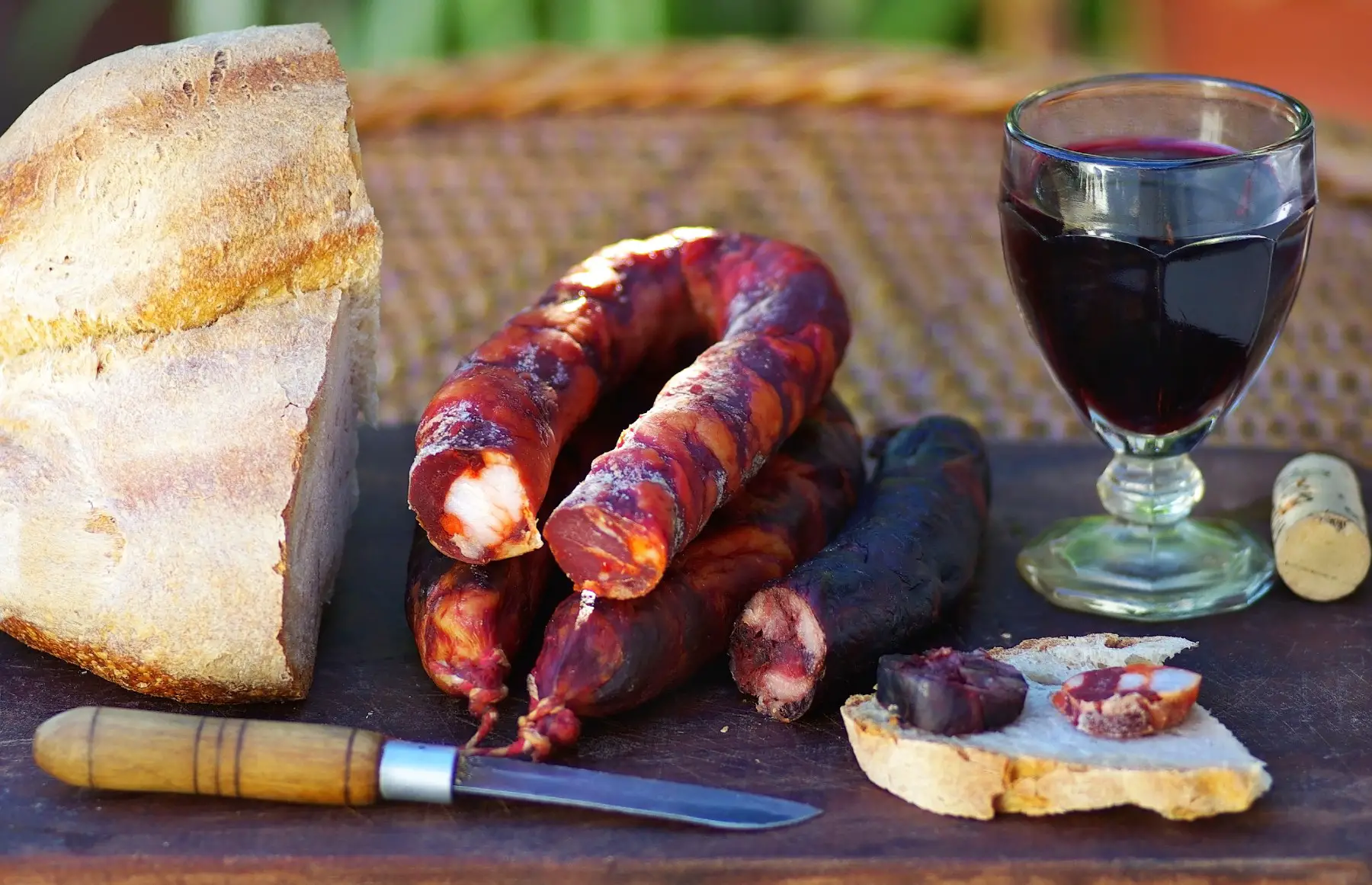
Cheese and dairy products in Portugal
Just like bread and wine, every region in Portugal has its own type of cheese (queijo). Many, but not all, have protected designation of origin (DOP) labels. The most famous cheese in Portugal is queijo da serra, a sheep cheese comparable to brie. People often enjoy it with Port wine. In the Alentejo region, you can try serpa, a sweeter cheese. The region is also famous for Queijo de Nisa and Queijo de Évora.
The Trás-os-Montes region of northern Portugal produces a hard and slightly spicy goat’s cheese called Queijo de Cabra Transmontano. Other strong varieties, such as cabreiro and queijo da ilha (similar to parmesan cheese) can also be found on the Azores Islands.
Herbs and spices in Portugal
Due to Portugal’s history in spice trading, Portuguese cuisine features more herbs and spices than other dishes from the Iberian region. You’ll typically find fresh coriander (coentros), mint (hortelã), and parsley (salsa) in recipes across the country. Coriander is often a key ingredient in soups and sauces and pairs nicely with fish and clams. It is also one of the ingredients used in the popular dish Açorda à Alentejana.
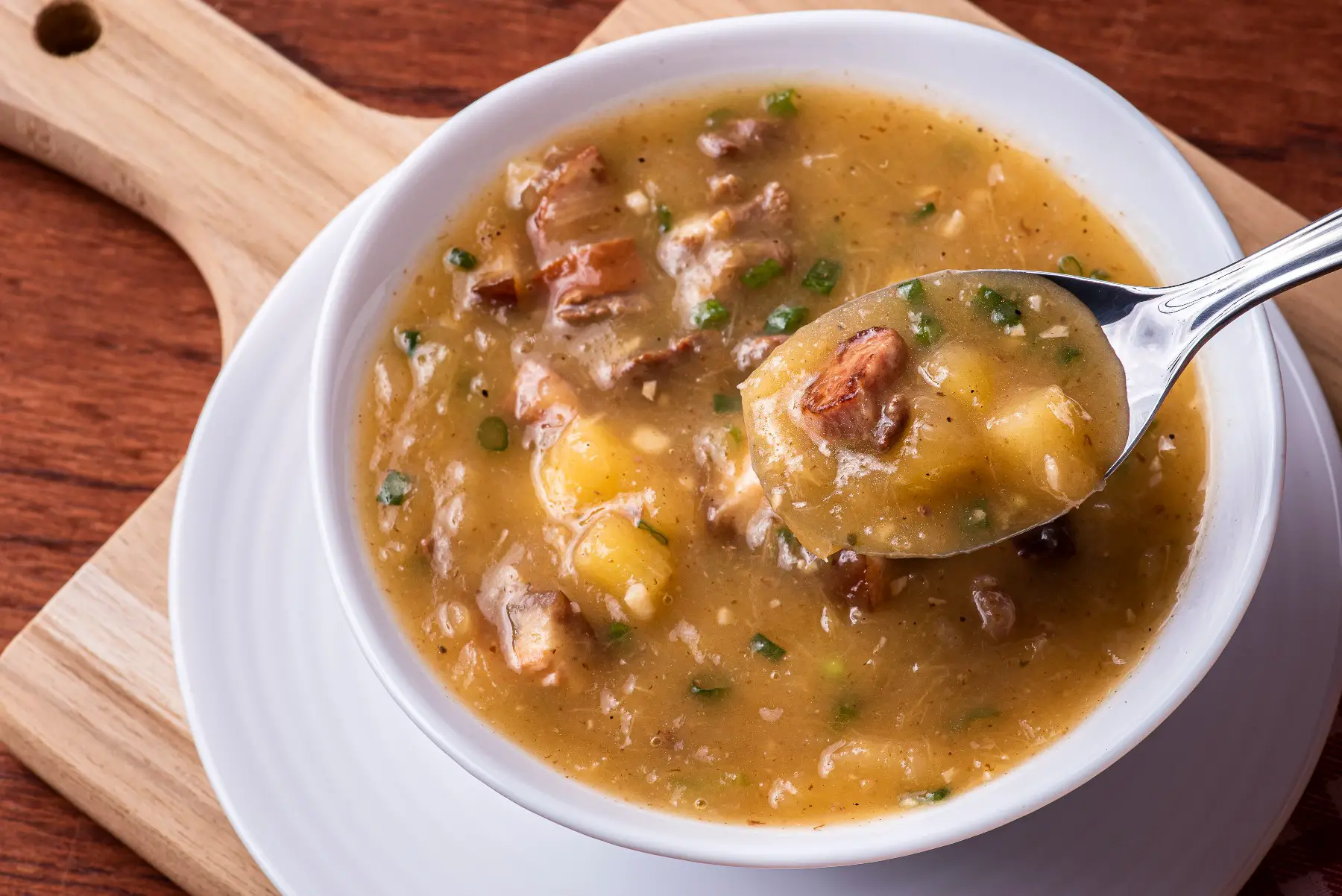
Similar to Spain and Italy, Portuguese cuisine uses a lot of garlic and olive oil. Many recipes also call for onions, bay leaves (louro), rosemary (alecrim), pepper (pimenta), lemon (limão), and paprika (colorau/pimentão-doce). In fact, paprika is a popular addition to meat marinades and roasts, and the Portuguese traditionally add it to their chorizos (chouriças). It is also used in the production of certain cheese varieties, which gives them a distinct color and flavor. The hot chili pepper variant, Piri-Piri, which originally cultivated in Mozambique, is also very common throughout Portuguese-speaking countries.
Sauces and condiments in Portugal
Piri-Piri spice is also used to make a spicy and tangy sauce that is typically served with chicken. Portuguese chimichurri sauce, called molho cru, has also been used in Portuguese cuisine for many centuries. People pour it over bacalhau assado (baked cod), as well as other fish dishes and grilled meats. You can also use it as a marinade for grilling meats, chicken, and shrimp. Interestingly, Portuguese sauce (made with curry and coconut milk) is not used in traditional Portuguese cuisine. It actually comes from Macau and is likely the result of Portugal’s colonization there.
Portuguese wine
When sampling Portuguese cuisine you might want to consider pairing your food with a local drink. Portugal is home to two wine-producing regions that are protected UNESCO World Heritage Sites. These are the Alto Douro Valley Wine Region (Douro Vinhateiro) and the Pico Island Wine Region (Ilha do Pico Vinhateira). Unsurprisingly, Portugal produces a wide variety of wines, which each have their own distinctive personality.
You’ve probably heard of Port wine, which gets its name from the city of Porto. There are several varieties of Port wine, and some of the most popular are Tawny, White, Ruby, and Late Bottled Vintage (L.B.V.). The second top exported Portuguese wine is Vinho Verde which is made from slightly under-ripened grapes.
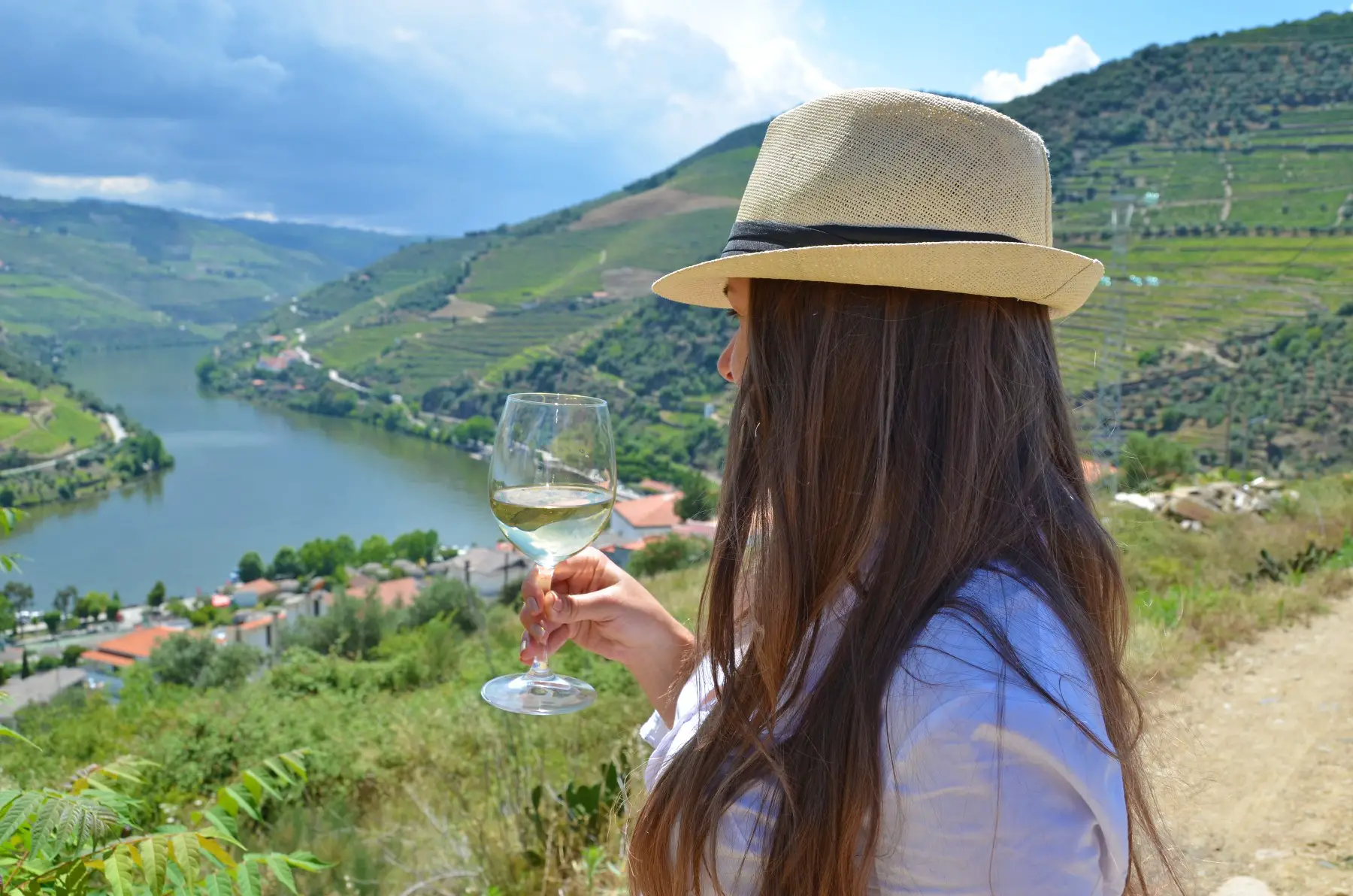
But if you’re not a wine lover, don’t despair, as Portugal has a long-brewing history. Although it isn’t as well-known as some of its European counterparts, the country’s beer culture, called Cervejaria, is widespread in all regions. Furthermore, there are several local brands that are popular with both locals and visitors alike.
The most famous Portuguese dishes
Cozido à portuguesa is a common and treasured Portuguese dish, which is mainly eaten in winter. The recipe for it somewhat parallels the French pot-au-feu or the New England boiled dinner. A lavish version may include beef, pork, salted pork, several types of assorted smoked sausages (charcutaria), pig’s feet, cured ham, root vegetables, cabbage, and rice.

The national dish of bacalhau (dried and salted codfish) is just one way to get your seafood fix in Portugal. Another option is Cataplana de Marisco, a popular fish or seafood stew that takes its name from a clam-shaped copper pot called a cataplana. This regional dish of the Algarve actually has Moorish origins. Roast suckling pig (leitão assado da bairrada) and Porco Preto are classic Portuguese pork dishes. The latter consists of black Iberian pig that is raised free-range in the central and southern regions of Portugal. Tripas à moda do Porto, meanwhile, is a rich meat dish that contains tripe, beans, and sausage, and is a specialty in Porto.
The most famous Portuguese desserts
Sweets are synonymous with pastries in Portuguese cuisine. In fact, the country produces at least two hundred different types of them. Many of their recipes date back to the 17th and 18th centuries when nuns in Portuguese convents made pastries. That’s why some have names such as toucinho do céu (heaven’s lard) and barriga de freiras (nun’s belly). Perhaps the most well-known and beloved, however, is the pastel de nata, a small custard tart sprinkled with cinnamon.
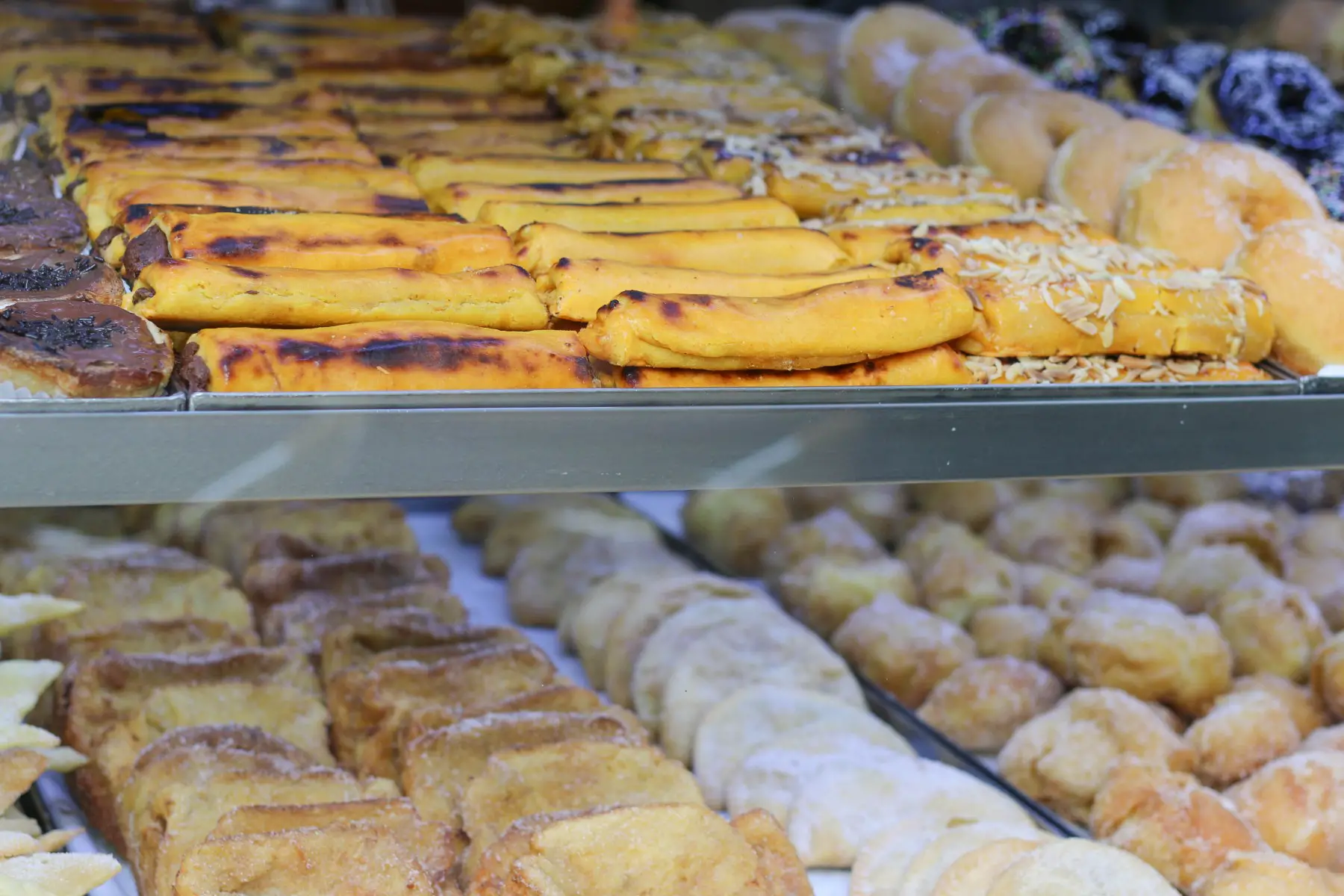
The Aveiro region produces ovos moles (egg paste pastries) which you might see in the shape of shells that decorate tarts, pies, and cakes. Other popular Portuguese desserts include pão de ló (a light sponge cake), palha Abrantes (a sweet candy made of loose egg threads), and pão de rala of Évora (a sweet, round bread made with almond-based dough and a white pumpkin center). If pastries don’t satisfy your dessert craving, though, Arroz doce is a traditional rice-based dessert that is famous throughout Portugal.
Regional differences in Portuguese cuisine
Although Portugal is only a small country, distinct regional influences do exist when it comes to the nation’s cuisine. As a result, your food experience will largely depend on where you live in the country.
Northern Portugal and Porto
Typical dishes from the north of the country are heavy and filling. Trás-os-Montes, a region in the top right corner, proudly claims to be the original creator of feijoada. This bean stew is now popular throughout Portugal. Here, you will also find alheira, a smoked sausage made with poultry, bread, and fat. Arroz de cabidela, meanwhile, is a rice dish that is made with chicken or game that is cooked in its own blood.

Tripe dishes, such as the famous tripas à moda do Porto, are specialties around Porto. Of course, Port wine also originates in the Alto Douro Valley Wine Region in northern Portugal. Vinho Verde wines are also produced in the north.
Central Portugal
Central Portugal claims to have the best oysters in the country, which come from the Aveiro estuary. You’ll also find a lot of game meat on menus across the region. One classic dish is Pastel de Molho da Covilhã, a filo pastry stuffed with ground meat braised in onions and bay leaves. Another recipe from the area is bucho, a savory blend of rice and pork meat that is cooked inside a pig’s stomach. The local version of the fish stew, caldeirada à Ria de Aveiro, is also famous here and includes ginger powder and pork.
Alejento
Recipes from Alejento usually include lamb or pork, but trout is also popular. The region is also proud of its specialty of bread and açordas or sopas de pão (bread and bean broth soup) which is great for dipping Alentejo bread. You can easily identify the local Evora cheese, too, as the circular and small shape is traditional in Alentejo. You can enjoy this slightly yellow cheese ripened, hard, or semi-hard. Alentejo is also one of Portugal’s top wine regions and is home to eight wine-producing subregions.
Lisbon
Sitting on an estuary near the ocean, fish and seafood are always on the table in Lisbon. Sardines are a symbol of the city and have been part of the local diet since the Moors conquered the city in the early 8th century. These days, you can buy beautifully designed sardine tins and enjoy eating tinned sardines (conservas) with different garnishes in cafes and bars.

Some of the most iconic recipes in Portuguese cuisine are from Lisbon. The pastel de nata (custard tart) was supposedly invented in Lisbon’s grand Monasterio de Jerónimos in Belém, which was next door to a sugar cane refinery. The national dish, bacalhau com broa (cod baked with cornbread) also has its roots in Lisbon. Moreover, one of the country’s most dynamic and varied wine regions runs from Lisbon northward along the coast.
Southern Portugal
Local dishes in the Algarve region feature a lot of shellfish. Conquilhas à Algarvia, for instance, is a dish with clams, fried onions, garlic, and sliced Portuguese sausage. You can also find pastries made with sweet marzipan or figs. These doces finos are sculpted into different shapes and are a point of significant regional pride in the Algarve. If you head inland towards the Montanhas region, you will mostly find eel or trout in seafood recipes. The main focus here is on alheiras, veal sausages, poultry, and ham.
Useful resources
- Visit Portugal – read more about Portuguese gastronomy on the official tourism website for Portugal
- Wines of Portugal – explore a map of Portugal and discover the varieties of wine produced in each region
- Roads & Kingdoms – discover the history of Lisbon in 10 dishes
- momondo – explore Portugal’s best wine regions
